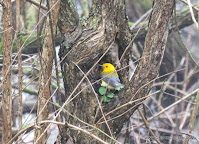 Recently, I made my annual pilgrimage and met a friend at the Biggest Week in American Birding. BWAB is a two-week
Recently, I made my annual pilgrimage and met a friend at the Biggest Week in American Birding. BWAB is a two-weekbird watching event, as colorfully plumed migrants, on their way from Central and South America, stop to feed before the long journey across Lake Erie into Canada. Participants register for presentations, field trips, guided walks on the amazing boardwalk, and to peruse nature-related vendors at Maumee Bay Lodge.
My three-and-a-half hour drive to Magee Marsh - part backroads, part interstate highway - was a bit grueling. Still not used to driving such long distances alone. But I'm adapting and learning to press on through the nervousness, boredom, and yet-to-figure-out-technology of my "new" 2018 Subaru.
But once I turned off the Lake Erie Coastal Highway
and into the Magee entrance, everything changed. After traveling at speeds of 60 to 70 mph, it was a warm welcome when the car in front of me meandered at a reasonable 25 mph, as did the car in front of it, and all the other cars I could see up the road. And honestly, 25 mph is even too fast when you're desperate to watch a pair of geese attending their adorable fluffs of offspring. I put the all the windows down to let the ubiquitous Yellow Warblers serenade me, flanked on both sides by wetlands filled with herons and egrets.
and into the Magee entrance, everything changed. After traveling at speeds of 60 to 70 mph, it was a warm welcome when the car in front of me meandered at a reasonable 25 mph, as did the car in front of it, and all the other cars I could see up the road. And honestly, 25 mph is even too fast when you're desperate to watch a pair of geese attending their adorable fluffs of offspring. I put the all the windows down to let the ubiquitous Yellow Warblers serenade me, flanked on both sides by wetlands filled with herons and egrets.
At that point, I was in birder's world, where the rules of engagement are different than at other public parks. After finding a parking spot among the hundreds of cars, with no less than 20 out of state license plates, I opened the door to the sound of nothing but birds and the lake crashing onto the shore in the distance.
In August of 2021, a major windstorm blew through the marsh and downed what looked like a third of the tall cottonwoods, maples, and other trees near or right on the boardwalk. Many sections were very damaged, which ODNR and volunteers needed to replace before the following spring. Many wondered how this opened canopy would affect not only the bird watchers, but more importantly, the birds. To everyone's delight the birds had no trouble adapting to the new landscape. In fact, all reports indicated this was one of the best years for viewing the great migration.
Together my friend and I recorded a total of 61 species, including 21 or the 36 species of wood warblers. My friend stayed a day longer and picked up another two warblers for 23 species. Most warblers and vireos were so close we could have reached out and touched them, or at the very least not used our binoculars to see their splendor. Each evening some percentage of the avian mix will take wing for the long flight over Lake Erie to Canada's boreal forest. There, they will nest in the spruces and pines and raise their broods. After that, they will reverse course and return to their wintering grounds, albeit less colorful than the trip up.
These birds are the jewels of spring to those of us who find their migrations fascinating; who understand the obstacles they overcome along the way, or don't - reflective glass on buildings, light pollution, habitat and resource loss. So, we also discuss how we can help in our own yards and communities by filling parts of them with native trees and shrubs. Over time, these plantings become filled with caterpillars, insects, and berries that each year give these weary travelers an oasis, both coming and going. All who wander (in the sky) are not lost. But all who wander need a meal and a place to rest on their journey.


